Apr 25, 2025
5 min read
Reggae music is more than just a sound, it's a cultural heartbeat from Jamaica. The most important part - reggae instruments makes it specialised in the world.
From deep basslines to skanking guitars and bubbling keyboards, each reggae instrument plays a vital role in creating the emotional feel of reggae.
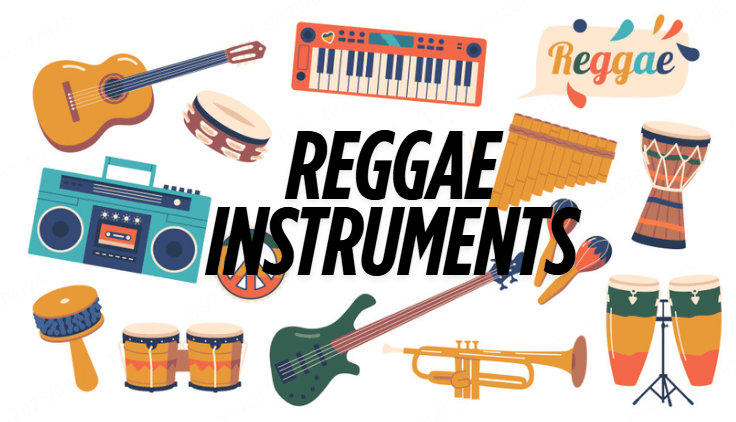
In this blog, we'll learn the instruments of reggae music, helping you understand its roots and rhythm better. Besides, we'll also show you how you creat your own reggae grooves as a beginner! Let's begin!
Part 1: The History and Evolution of Reggae Instruments
1. Reggae Music History
Reggae music first started in Jamaica in the late 1960s. It came from earlier types of music like ska and rocksteady, which were popular in the Caribbean. Ska was fast and full of horns, while rocksteady was slower with a stronger focus on bass and vocals.
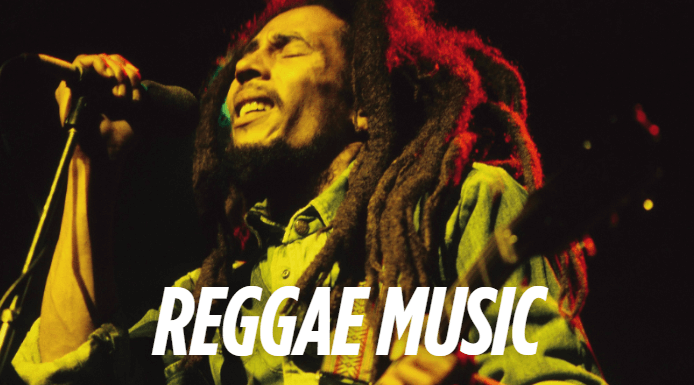
When reggae was born, it brought a new rhythm style called the "one drop" beat, where the drum hits on the third beat. This is what gave reggae its relaxed and groovy feel. Reggae also became known for its deep messages about love, unity, and social change.
2. Evolution of Reggae Instruments
As the music changed, so did the instruments. In the beginning, many reggae instruments were the same as ska—like guitars, drums, and horns—but they were used in new ways.
In the 1970s, people who created reggae music added effects like echo and reverb to make the music sound bigger. This style is called dub reggae.
Later, digital instruments like drum machines and keyboards became popular. But the key reggae sound stayed the same — deep bass, steady rhythm and feeling.
Part 2: Key Instruments of Reggae Music and Their Roles
Each of the key reggae instruments has a specific job – together, they form the "riddim," or rhythm section, which is the foundation of nearly every reggae song.
Knowing about these instruments and how they contribute to the music helps us understand the structure and soul of this genre, which many people around the world love. Let's break them down one by one!
1. Bass Guitar – The Melodic Backbone of Reggae
In most genres, the bass plays a supportive, background role. In reggae, it's very important.
The bass guitar is the heartbeat of the reggae beat, creating a deep, rolling, hypnotic sound. Reggae basslines are simple but powerful. They are often repetitive and syncopated, creating a "bed" for other instruments to sit on.
● Common style: Deep tones, minimal note changes, lots of space.
● Iconic player: Aston "Family Man" Barrett(The Wailers).
● Why it matters: Bass in reggae isn't just rhythm—it's storytelling.
2. Drums – Creating the Iconic One Drop Rhythm
The drum kit is the most important part of reggae music. It is the reason why reggae has a "one drop" rhythm. This is where the snare and bass drum hit together on the third beat of the bar, creating a relaxed yet bouncing feel.
Key components:
● Kick drum: Often silent on beat one.
● Snare drum: Played on the third beat—defining the "one drop.""
● Hi-hats: Closed and tight, playing eighth notes or syncopated rhythms.
● Effect: The groove feels like it "pulls back," which encourages head-nodding and body-swaying.
3. Rhythm Guitar – The Skank That Keeps the Bounce(H3)
The rhythm guitar in reggae plays sharp, muted chords on the offbeats, usually beats 2 and 4. This technique is called "skanking" and it's one of the most recognizable sounds in reggae music.
● Strumming style: Upstroke or downstroke with damping for percussive effect.
● Tone: Clean with minimal distortion.
● Role: Adds rhythmical punch and energy.
Imagine it's like the click track of reggae music – it doesn't lead the way, but it keeps everything in time.
4. Keyboard and Organ – The Bubble and Harmony Layers
The keyboard(or Hammond organ) creates the harmony and adds that warm, bouncing effect known as the "bubble".
● The Bubble: A syncopated pattern played between the guitar skanks.
● Organ chops: Add reverb-heavy stabs for a "rootsy" feel.
● Dub role: In dub reggae, keyboards are often manipulated with echo and delay.
The bubble rhythm helps keep the groove and energy going, without making the track too overwhelming. The rhythm guitar creates a call-and-response feeling.
5. Horn Section – The Soulful Flourish
Brass instruments are often used in reggae, but only a little bit.
● Typical setup: Trumpet, saxophone, and trombone.
● Usage: Short melodic phrases or stabs, usually in choruses.
● Dub adaptation: Often echoed or reverbed to create spacious, ethereal effects.
Horn lines often echo the vocals or create a bright contrast to the deeper bass and drum layers.
6. Percussion – Adding Cultural Texture and Rhythm Layers
In addition to the main drum kit, reggae uses various hand percussion instruments that show its African and Caribbean roots.
● Common percussion: Bongos, congas, shakers, timbales, and Nyabinghi drums.
● Cultural importance: Nyabinghi drumming comes from Rastafarian ceremonies and is deeply spiritual.
● Musical purpose: These instruments fill the rhythmic space, add movement, and build emotional energy.
Part 3: Bonus: How to Make Reggae Instrumental Music?
After learning about reggae musical instruments, would you like to make your own reggae music? It might sound like a big task—but with the right tools like Musicful, it's easier than ever.
Musicful is an advanced AI reggae maker that creates high-quality reggaeton tracks in seconds.
Just enter a description or lyrics, choose reggaeton as the style, and let the AI do the rest.
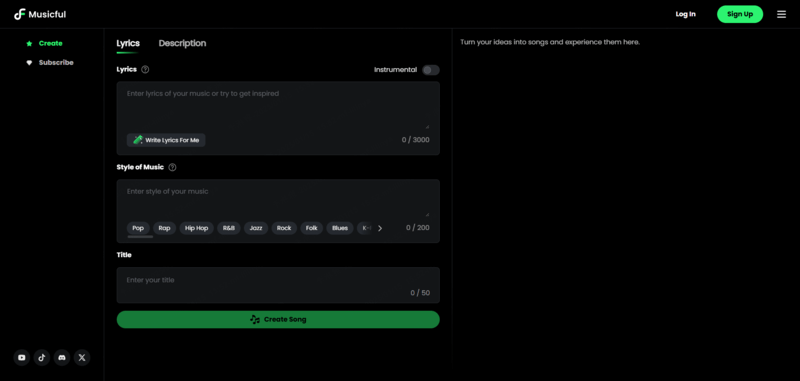
Step-by-Step: Create Reggae Music?
Step1️⃣. Click on the green square below.
Step2️⃣. After log in, enter the lyrics and your music styles, like "Reggae,Energetic". If you don't have lyrics, you can click "Write Lyrics for Me", input "reggae" and let AI generare the lyrics. Or choose "Description", enter your description about your song.
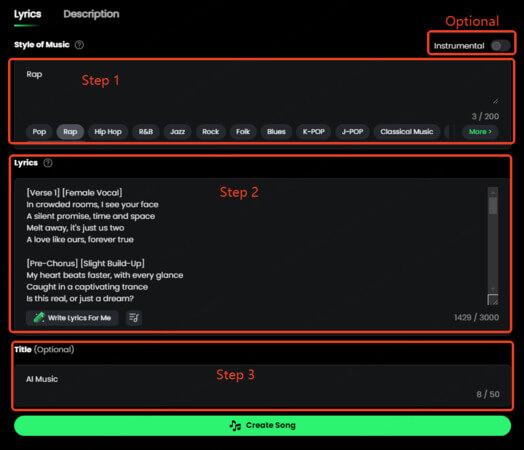
Step3️⃣. You can enter your song title(optional). After clicking "Create Song", you can download the mp3 or MIDI formats. Or copy the link to share with your friends. Enjoy this reggae music below.
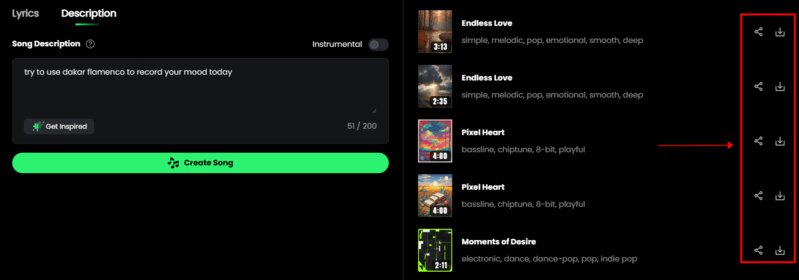
Part 4: FAQ about Reggae Instrumental
1. What is instrumental reggae called?
Instrumental reggae is often known as "dub" reggae. In dub music, the singer's voice is either taken out completely or made really quiet.
The focus is on the beat, the bass and the effects. This style shows the musical power of reggae instruments without using any lyrics.
2. What instrument is best for reggae?
The bass guitar is the most important instrument in reggae music. It sets the rhythm and creates a deep, groovy vibe that is typical of reggae. Reggae doesn't feel right without a strong bassline.
3. What is the number 1 reggae song?
One of the most famous reggae songs is "No Woman, No Cry" by Bob Marley and the Wailers. It's a classic reggae song that captures the essence of the genre – it's emotional, socially conscious, and melodic.
4. What is the famous reggae drum beat called?
The most famous reggae drum pattern is the "one drop" beat. It puts the snare drum and the kick drum together on the third beat of the bar, which gives reggae its relaxed rhythm and flow.
Conclusion
Reggae wouldn't be reggae without its signature instruments.
Each of the essential reggae instruments—bass, drums, guitar, keyboard, horns, and percussion—brings a unique layer of rhythm, soul, and emotion. Together, they make a type of music that is full of spirit and loved all over the world.
And if you want to start making your own reggae music, try Musicful - an AI music generator that can help you create reggae instrumentals easily, whether you're a beginner or pro!
Stay inspired, keep listening, and let the heartbeat of reggae guide your musical journey.



